
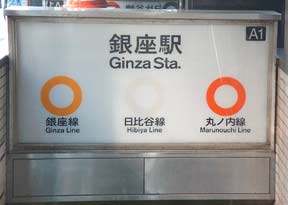
The Ginza area of Japan is one of the most expensive few blocks of real estate in the world. It also ranks among the world's most concentrated retail areas. The brilliantly lit signage crowding every street, although primarily vertical in the Japanese tradition, brings to mind what one would see in Las Vegas.
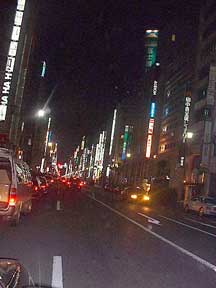
Like anywhere, street frontage is the premier store position. However, because of the enormous number of visitors to the area, even the businesses in basement cubbyholes and tiny upper-floor locations seem to be thriving. Like most other places in city areas in Japan, many sections of Ginza area buildings have their own elevators, so each floor houses just one shop, restaurant, etc.
On a weekend night, the Ginza is obviously 'the' strip for motorists of all ages to cruise. Combined with the taxi traffic, because of its narrow and crowded streets, (Tokyo had more taxis than anyplace I've ever been), the result is an exciting, unique vibrancy of character.
As Hiroshi Hashimoto drove us through the streets of Ginza on the Saturday night following our exquisite meal, the entire area was a scene of frenetic activity, like a beehive that's been hit with a stick. Everyone seemed to be hurrying from one place to another, as if afraid of missing something. Because the area was so packed, I was quite surprised when Hiroshi mentioned there would, most likely, be even more people there the next day. I promised myself I'd come back to see.
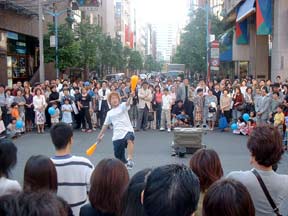
On Sunday, about midday, I re-entered the Ginza on foot. It turned out to be a short, 10-minute walk from my hotel. From the time I started out, I was surprised at the number of pedestrians on the sidewalks, although car traffic was nothing like it had been the night before. Even keeping in mind what Hiroshi had said, I wasn't prepared for what I saw once I arrived in the main Ginza area.
Several streets were blocked off to car traffic, and these pavilions were crammed cheek-to-jowl. While the atmosphere had been frenetic the evening before (with what might be termed a 'high level of testosterone in the air'), today the area was filled with happy couples and families with children. All were strolling around with no seeming concern for speed or destination.
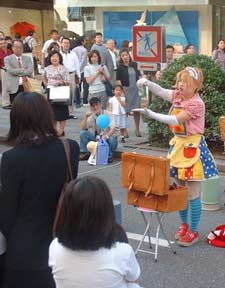
The sound of happy voices was everywhere, along with the sight of smiling people, many eating one of the many food items being sold by the streetside vendors. Street performers were in evidence every block or so: jugglers, musicians, clowns, and even a dancer. The clown was extracting peals of laughter from the crowd by pulling a series of items out of an oversized handbag. Not only did I fail to recognize a few of the items, but the entire performance didn't seem that funny to me! It made me realize how much our culture influences our concept of humor. All in all the Ginza, at least on this particular Sunday, was a very happy place.
Although the pavement area seemed clean enough, especially considering the huge crowd using it both then and the night before, I was surprised to see garbage bags, full of trash, dotting the curbs here and there on the side streets. That fact, alone, prompted me to want to know more.
The next day, I made a call to Tokyo Metropolitan Government, the agency responsible for sweeping most of the main streets of Tokyo. I learned that the area considered to be the Ginza is about 860,000 square meters, or a little less than a square kilometer in size. Ginza is located in Chuo ward, and Chuo ward is responsible for all garbage collection in Ginza, with the exception that some of the large building owners consign garbage collection to private companies. The shopkeepers are responsible for keeping the areas near their stores swept with brooms. Then, they bag up their sweepings and put them out on the curb for collection by a garbage truck.
There are three kinds of road in Ginza. First, are the roads administrated by the Ministry of Land, Infrastructure and Transportation. They consist of national highways and main streets. Second, are the roads administrated by the Tokyo Metropolitan Goverment. They are called the 'Tokyo Metro roads,' and are primarily main streets. Third, are the roads administrated by Chuo ward. They are called the 'ward roads,' which include a few main roads, but primarily back roads. Each government organization is in charge of sweeping their respective roads, but all garbage bag collecting is done solely by Chuo ward.
Some of the 'ward roads' in and around the Ginza are swept by a sweeping company that has a contract with Chuo ward, but I was unable speak with them due to the language difficulty. I did learn that they use mechanical sweepers, and have a contract that calls for sweeping a mere 4200km per year. That translates to only 1.5 sweeps per week for the entire road area under contract, which is probably why some of the area wasn't as clean as I thought it might have been.
The main roads in and around the Ginza (an area totaling 31km) are swept every night by another sweeping company that has a contract with Tokyo Metropolitan Government. They use a lead car for safety, which is followed by a water truck, then a sweeper, then a follow-up truck to pick up big stuff that won't fit into a sweeper.
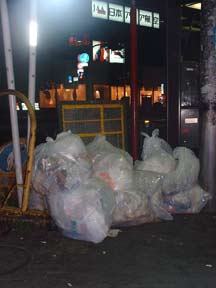
It was Sunday, so the unsightly bags may have been there due to the garbage collection system for that area. Burnables, I was told, are collected every day except Sunday, while non-burnables are collected only five times per week. All in all, there's no question that those who clean up the Ginza are faced with a challenging task. And, except for the garbage bags, it seemed to be done quite well.
I was surprised by one aspect of the interview process, however. Armed with a list of questions, I called the Tokyo Metropolitan Government offices, and was transferred to the English-speaking division. The official in charge of assisting me wasn't sure how long it would take to find the answers I needed, so I suggested that she call me at my motel whenever she had compiled the information. I didn't realize that simply was not done! My contact explained that she was a member of the Tokyo Government, and "We do not call people back on a telephone. People call us back." Although a bit taken aback by this policy, I tried not to show my surprise and readily agreed on a time later in the day when I would give her a call. Still, I couldn't help but wonder how similar politics would fare in the U.S.
If you're ever in Tokyo, be sure to visit the Ginza area of town. It's sure to provide you with some sights, sounds and memories you'll remember for long after you leave.
Next, we'll be investigating what is changing the face of sweeping across metropolitan Japan. Mechanical broom sweepers, which have held a virtual monopoly on sweeping, appear to be on the wane for a reason that, to me, is quite surprising.

